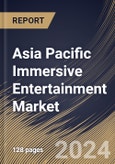This cross-platform immersion allows for more dynamic and versatile storytelling, enabling creators to craft experiences seamlessly blending the virtual and physical worlds. This form of entertainment has ushered in a new era of storytelling. Creators are now exploring interactive narratives where users play an active role in shaping the story's outcome. This trend reshapes traditional entertainment formats, offering audiences personalized and participatory experiences. Virtual spaces for real-time collaboration have gained traction, particularly in the corporate and educational sectors. Virtual meetings, conferences, and collaborative workspaces allow users to interact and engage in a shared digital environment, transcending geographical limitations.
The gaming industry has been at the forefront of the entertainment, with VR and AR technologies enhancing the gaming experience. VR headsets provide gamers a more immersive and realistic environment, while AR overlays digital elements onto the physical world. Esports, too, has embraced immersive technologies to elevate the spectator experience, blurring the lines between gaming and traditional sports. Immersive technologies are reshaping the film and television industry by offering audiences a more engaging and interactive viewing experience. VR films and 360-degree videos immerse viewers in the story, while AR applications provide additional information or interactive elements during live broadcasts.
Invest India projects that by 2030, the media and entertainment sector in India will be worth $100 billion. The digital media subsegment, which is the second largest, is projected to increase by 30% to $6.9 billion by 2022. Additionally, according to the State Council, in 2023, the sales revenue of China's game industry hit nearly 29.23 billion yuan, expanding by 46.08 percent year on year. The revenue of China's mobile game industry surged 63.73 percent year on year to 22.85 billion yuan. Therefore, the factors mentioned above will propel market growth in this region.
The China market dominated the Asia Pacific Immersive Entertainment Market, by Country in 2022, and would continue to be a dominant market till 2030; thereby, achieving a market value of $29,882.3 Million by 2030. The Japan market is registering a CAGR of 23.4% during (2023 - 2030). Additionally, The India market would showcase a CAGR of 25% during (2023 - 2030).
Based on Technology, the market is segmented into Virtual Reality (VR), Augmented Reality (AR), Mixed Reality (MR) and Others. Based on Application, the market is segmented into Gaming, Music & Concerts, Immersive Theater, Arcade Studios, Live Events, Sports, Museum & Cultural Experiences and Others. Based on countries, the market is segmented into China, Japan, India, South Korea, Singapore, Malaysia, and Rest of Asia Pacific.
List of Key Companies Profiled
- Meta Platforms, Inc. (Meta)
- Microsoft Corporation
- HTC Corporation
- Barco NV
- Magic Leap, Inc.
- Samsung Electronics Co., Ltd. (Samsung Group)
- Apple, Inc.
- Sony Corporation
- Qualcomm Incorporated (Qualcomm Technologies, Inc.)
- Unity Software, Inc.
Market Report Segmentation
By Technology- Virtual Reality (VR)
- Augmented Reality (AR)
- Mixed Reality (MR)
- Others
- Gaming
- Music & Concerts
- Immersive Theater
- Arcade Studios
- Live Events
- Sports
- Museum & Cultural Experiences
- Others
- China
- Japan
- India
- South Korea
- Singapore
- Malaysia
- Rest of Asia Pacific
Table of Contents
Companies Mentioned
- Meta Platforms, Inc. (Meta)
- Microsoft Corporation
- HTC Corporation
- Barco NV
- Magic Leap, Inc.
- Samsung Electronics Co., Ltd. (Samsung Group)
- Apple, Inc.
- Sony Corporation
- Qualcomm Incorporated (Qualcomm Technologies, Inc.)
- Unity Software, Inc.








